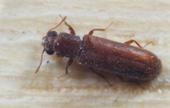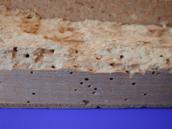Powder post beetle (Lyctus spp.)
Powder post beetles (Lyctus spec.) can be found throughout the entire world. They are deciduous wood pests and prefer to attack the high-starch sapwood in deciduous trees with medium to large moisture conducting tracheids and are most frequently found in oak, ash, elm, maple and poplar trees, as well as in tropical wood species such as limba and abachi.
In Central Europe, the Lyctus linearis and the Lyctus brunneus species of powder post beetle are also found. Of all the drywood insects, powder post beetles are those requiring the least moisture and can thrive in wood products in houses and apartments, such as banisters, panelling and wooden floor boards.
What do powder post beetles look like?
Powder post beetles grow to about 3- 5 mm. Their bodies are long and flat, and their colour ranges from red to dark brown, depending on the species. The larvae are pale cream, up to 5mm long and curved. At the end of the abdomen, they have a large oval stigma, which distinguishes them from the larvae of the common furniture beetle.
How do they attack the wood?
Powder post beetles appear in May or June and after mating, the female lays her eggs in the cut fibres of large pored timbers, wood cracks or old exit holes. The larvae develop in the sapwood of the infested timbers. The frass galleries initially run with the grain, but can branch out at later stages and are filled with a fine, flour-like bore dust. The outer layers of the wood are not attacked by the larvae. The hatching adult beetles gnaw their way through the outer surface after approximately one year, leaving 1-2 mm exit holes which may be the only outward sign of infestation. If infestation is particularly extensive, the entire interior of a timber can be reduced to a powdery mass. Such extensive infestation is always limited to high-starch sapwood, as the larvae cannot digest the cellulose in the wood cell walls.
What can be done to comat infestation?
The curative treatment for powder post beetle infestation involves the application of effective wood preservative by means of soaking or injecting. As a rule, this also provides preventive protection against renewed attack.

